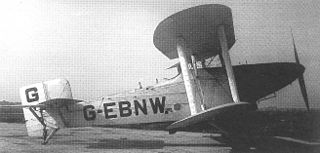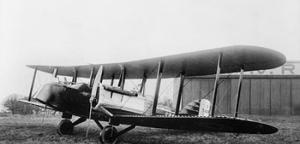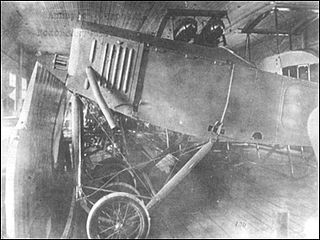
The Avro Andover was a 1920s British military transport aircraft built by Avro for the Royal Air Force. Four aircraft were built, in two versions. Three aircraft, the Type 561, were used as flying ambulances. The sole example of the Type 563 was used as a 12-seater transport.

The Avro 549 Aldershot was a British single-engined heavy bomber aircraft built by Avro.

The Avro 566 Avenger was a prototype British fighter of the 1920s, designed and built by Avro. It was a single-seat, single-engine biplane of wood and fabric construction. Although it was a streamlined and advanced design, it never entered production.

The Avro Type 584 Avocet was a British single-engined naval fighter prototype, designed and built by Avro. While the Avocet was not built in numbers, one of the prototypes was used as a seaplane trainer for the Royal Air Force's (RAF) High Speed Flight.

The Avro Cadet is a single-engined British biplane trainer designed and built by Avro in the 1930s as a smaller development of the Avro Tutor for civil use.
The Avro 558 was a British single-engined ultralight biplane built by Avro at Hamble Aerodrome.

The Avro 560 was a British single-engined ultralight monoplane built by Avro at Hamble Aerodrome.

The Avro 571 Buffalo was a prototype British carrier-based torpedo bomber biplane, designed and built by Avro in the 1920s. It was not selected for service, the Blackburn Ripon being ordered instead.

The Avro 604 Antelope was a British light bomber which was designed and built in the late 1920s to meet a requirement for a light bomber to equip the Royal Air Force, competing against the Hawker Hart and the Fairey Fox II. It was unsuccessful, the Hart being preferred.

The Avro 627 Mailplane was a British biplane developed in 1931 by Avro from the Avro Antelope bomber as a mail plane for use in Canada. Only one was built which ended up being used as a test bed.
The Avro 636 was a single-engined British fighter-trainer built by Avro in the mid-1930s. Four were built for the Irish Air Corps.

The Avro 641 Commodore was a British single-engine five-seat cabin biplane built by Avro in the mid-1930s for private use. A total of only six were built, including the prototype.

The Avro Type E, Type 500, and Type 502 made up a family of early British military aircraft, regarded by Alliott Verdon Roe as his firm's first truly successful design. It was a forerunner of the Avro 504, one of the outstanding aircraft of the First World War.
The Avro 519 was a British bomber aircraft of the First World War, a development of the Avro 510 seaplane. They were two-bay biplanes of conventional configuration with greatly uneven span. Two single-seat examples, powered by a single 150 hp (110 kW) Sunbeam water-cooled engine, were ordered by the RNAS in early 1916. This was soon followed by orders for two modified aircraft for the Royal Flying Corps. These were fitted with seats for a crew of two and had more powerful (225 hp/168 kW) Sunbeam engines

The Avro 523 Pike was a British multi-role combat aircraft of the First World War that did not progress past the prototype stage. It was intended to provide the Royal Naval Air Service with an anti-Zeppelin fighter that was also capable of long-range reconnaissance and bombing.
The Avro 521 was a British two-seat fighter first flown in late 1915, based on the 504. Only a prototype of the Avro 521 was built. It was powered by a 110 hp (80 kW) Clerget engine, with provision for a .303 in (7.7 mm) Lewis Gun in the rear cockpit.

The Avro 530 was a British two-seat fighter biplane designed in 1916 to compete with the Bristol F.2A. The plane itself was designed in 1916, but not flown until July 1917. It was of fabric-covered wooden construction, powered by a 200 hp (150 kW) Hispano-Suiza engine.

The Avro 533 Manchester was a First World War-era twin-engine biplane photo-reconnaissance and bomber aircraft designed and manufactured by Avro.
The Avro 528 was an unsuccessful large span single-engined biplane built to an Admiralty contract in 1916. It carried a crew of two; only one was built.

The Sikorsky S-17 was a Russian single engine aircraft built at the Russian Baltic Railroad Car Works in Petrograd while Igor Sikorsky was the chief engineer of the aircraft manufacturing division.
















